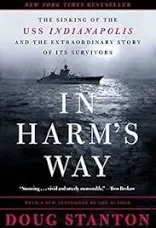In Harm’s Way
by Doug Stanton
“As the water flashed with twisting tails and dorsal fins, the boys resolved to stay calm, clamping their hands over their ears against the erupting screams, but this resolve vanished when one of the boys was dragged through the water like a fisherman’s bobber tugged by a big catfish. The victim, clenched in the uplifted jaws of a shark, was pushed at waist level through the surf, screaming. Others disappeared quietly without a trace, their life vests shooting back to the surface empty, the straps in shreds. As the excited sharks grew more agitated, the attacks intensified in ferocity.”
The sinking of the U.S.S. Indianapolis in late July 1945 is one of the most infamous stories to come out of World War II naval history. After delivering the bomb (yes, that bomb) to Tinian on a top-secret mission, the Indianapolis was set to rejoin the fleet in Leyte to begin preparations for the invasion of Japan. It never made it. Unescorted and torpedoed by a Japanese submarine, the Indianapolis sank within minutes. Three hundred sailors died instantly. Nine hundred were left to fend for themselves in the middle of the Pacific. As they floated, they lacked food and drinkable water. They experienced dementia, hypothermia, hopelessness, and of course, sharks. In the end, just over three hundred souls survived. In Harm’s Way is required reading for those interested in the limits of human survival, World War II, U.S. Naval history, and frustratingly, the bureaucratic failures which left the survivors alone, floating helplessly while the Navy was clueless to their situation.
Reading this riveting story, one is struck by mankind’s survival capacity and sheer will power. It is hard to fathom why some men succumbed to dementia and hallucinations while others did not. How did those, not taken by sharks, maintain their will to live while others simply gave up and floated away to die? To its credit, the book doesn’t try providing these answers. Rather, In Harm’s Way is more interested in the individual stories of those that survived. It seeks to put us among these sailors and explores the extent of what one can physically and psychologically endure.
Beyond the harrowing experiences of the survivors, the book does an excellent job explaining the complete breakdown in the Navy’s ability to discover that one of its ships was missing. It was a multipoint failure that turned a disaster into a tragedy. For instance, the Indianapolis was denied an escort as it sailed to Leyte, even though this stretch of ocean was known to have active Japanese submarines. This fact was known to those briefed on intelligence from ULTRA (the U.S. code breaking program), to which the Indianapolis’ Captain, Charles McVay, was not. The SOS signals sent right before the U.S.S. Indianapolis sunk were dismissed as pranks since they couldn’t be confirmed by the sender (how could they?). The harbor masters in Leyte, expecting the U.S.S. Indianapolis’ arrival, didn’t follow up with anyone when she failed to arrive. They either assumed the ship had arrived or it was redirected elsewhere. But no one asked the question.
Also frustrating was McVay’s court martial, where the above failures were not presented or even brought to light. As Stanton points out, “the question as to why 900 U.S. sailors were left to float for as many as 5 days in a hostile ocean would not be considered by the court. The conduct of the Navy would not be on trial.” It was decided that McVay was to be the scapegoat. The subsequent guilt he carried around for the rest of his life was tremendous – after all, he survived the disaster while so many under his command did not. Even as he floated in the ocean with his crew, he knew a court martial awaited him if he lived. The guilt, the ruined career, the hate mail he received cost him his life. He committed suicide in 1968.
To me, this story is about more than just man’s ability to survive in the worst circumstances. It is also a story of utter helplessness when an entire bureaucratic machine is stacked against you. The failure of the machine to mount a rescue mission days after the fatal incident is damning, as is their conduct afterward. In the court martial, this same machine decided which evidence to use and what evidence to withhold. McVay didn’t stand a chance. The Navy made its decision before the trial began. It would take almost sixty years for this injustice to be overturned.
The U.S.S. Indianapolis holds is an important part in naval history and the events surrounding its sinking are ones everyone should know. This is not just because it is an incredible story of human survival, but it is also a cautionary tale of what happens when a self-serving bureaucratic system without checks and balances fails. So much damage can be done. However, I take solace that in the end, the truth will emerge so posterity can appropriately validate the historical record.
